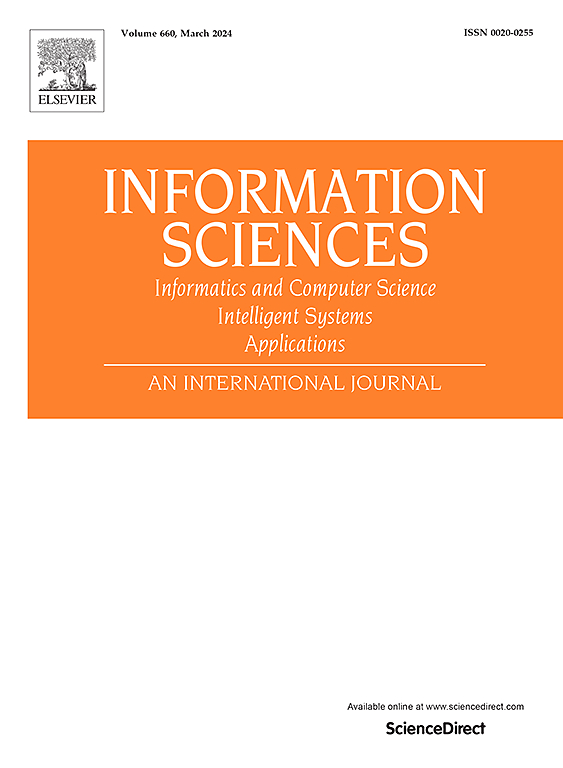一种双方型多关系异构图的关系分类和聚合算法
IF 6.8
1区 计算机科学
0 COMPUTER SCIENCE, INFORMATION SYSTEMS
引用次数: 0
摘要
现有的异构图神经网络(hgnn)是多面向、单关系的异构图,不能有效地在多关系的双方型多关系异构图(BMHGs)上运行。同时,现有的基于元路径的hgnn在聚合过程中不能充分考虑元路径之间的差异,这种差异在bmhg中表现得更为突出。主要表现为各种元关系路径连接的邻居节点数量差异较大,导致某些路径携带过多的噪声信息,影响算法性能。针对双方多关系异构图中关系复杂、路径间邻居数差异大的问题,提出了一种双方多关系异构图(RCAA-BMHG)关系分类与聚合算法。RCAA-BMHG算法包括同类型聚合模块、跨类型聚合模块和跨类别特征聚合层三个模块,分别对双方多关系异构图中节点之间不同类型的关联信息进行差异化处理。具体来说,同类型汇聚模块首先引入同类型节点关联过滤器来区分密耦合路径和稀疏耦合路径,然后采用全局平均策略和自适应权重分配方法对两类耦合路径的信息进行汇聚。通过跨类型节点关联过滤器对跨类型聚合模块进行过滤,然后利用加权和机制和邻域特征传播技术对两类耦合路径信息进行聚合。最后,RCAA-BMHG利用类别级关注机制融合相同和交叉类型的语义和特征信息,生成下游任务的最终节点嵌入。实验验证表明,RCAA-BMHG算法在处理复杂异构图数据时不仅能够完成特征聚合和分类任务,而且在多个评价指标上也比现有hgnn算法具有显著优势。完整的可复制代码和数据已发布在:https://github.com/Dylanwsd24/RCAA-BMHG。本文章由计算机程序翻译,如有差异,请以英文原文为准。
A relation classification and aggregation algorithm for bipartite-type multi-relational heterogeneous graphs
Existing Heterogeneous Graph Neural Networks (HGNNs) are multi-oriented and single-relational heterogeneous graphs, and cannot effectively function on Bipartite-type Multi-relational Heterogeneous Graphs (BMHGs) with multiple relationships. At the same time, existing meta-path-based HGNNs cannot fully consider the differences between meta-paths during the aggregation process, and this difference is even more prominent in BMHGs. The main manifestation is that the number of neighbor nodes connected by various meta-relation paths differs significantly, causing some paths to carry too much noise information, which affects the algorithm performance. In order to solve the problem of the complex relationships in BMHG and the significant disparity in the number of neighbors between paths, this paper proposes a Relation Classification and Aggregation Algorithm for Bipartite-type Multi-Relational Heterogeneous Graphs (RCAA-BMHG). The RCAA-BMHG algorithm consists of three modules: the same-type aggregation module, the across-type aggregation module, and the cross-category feature aggregation layer, which perform differentiated processing of different types of association information between nodes in a Bipartite-type Multi-relational Heterogeneous Graph. Specifically, the same-type aggregation module first introduces a same-type node association filter to distinguish between the densely coupled path and the sparsely coupled path, and then uses a global average strategy and an adaptive weight allocation method to aggregate the information of the two types of coupled paths. The across-type aggregation module is filtered by an across-type node association filter, and then the weighted sum mechanism and the neighborhood feature propagation technology are used to aggregate the information of the two types of coupled paths. Finally, RCAA-BMHG uses a category-level attention mechanism to fuse the semantic and feature information of the same and cross types to generate the final node embedding for downstream tasks. Experimental verification shows that RCAA-BMHG not only performs feature aggregation and classification tasks when processing complex heterogeneous graph data, but also shows significant advantages over existing HGNNs algorithms on multiple evaluation metrics. The complete reproducible code and data have been published at: https://github.com/Dylanwsd24/RCAA-BMHG.
求助全文
通过发布文献求助,成功后即可免费获取论文全文。
去求助
来源期刊

Information Sciences
工程技术-计算机:信息系统
CiteScore
14.00
自引率
17.30%
发文量
1322
审稿时长
10.4 months
期刊介绍:
Informatics and Computer Science Intelligent Systems Applications is an esteemed international journal that focuses on publishing original and creative research findings in the field of information sciences. We also feature a limited number of timely tutorial and surveying contributions.
Our journal aims to cater to a diverse audience, including researchers, developers, managers, strategic planners, graduate students, and anyone interested in staying up-to-date with cutting-edge research in information science, knowledge engineering, and intelligent systems. While readers are expected to share a common interest in information science, they come from varying backgrounds such as engineering, mathematics, statistics, physics, computer science, cell biology, molecular biology, management science, cognitive science, neurobiology, behavioral sciences, and biochemistry.
 求助内容:
求助内容: 应助结果提醒方式:
应助结果提醒方式:


